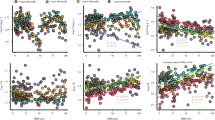Summary
Near terminal foliage was sampled from 26 young, open-grown trees in each of three red pine plots on a potassium deficient site. The plots were respectively control, trees fertilized with potassium in the nursery and trees fertilized with potassium in the field.
Multiple regressions relating tree height and leader length to foliar concentrations of sodium, potassium, calcium, magnesium, manganese, phosphorus, nitrogen, and silica were calculated to test Leyton's hypothesis that only deficient nutrients would be significantly related to growth in such equation.
The hypothesis was supported by the pooled data and by the data from the trees fertilized in the nursery but not from the other two plots.
The different elements were interrelated in the leaves so that results of multiple regression analyses were strongly influenced both by the combination of regressor variables used as well as by which one of a number of interrelated growth measurements was used as dependent variable.
The closeness of correlation between variables and the chances of incorrect predictions appear to increase with severity of deficiency. However it was possible to relate leader length to foliar potassium in all three plots by one second-order polynomial regression which accounted for 66 per cent of the observed variation in leader length.
The data confirmed the conclusion of Stoneet al. that excellent growth of red pine is possible when there is 450 mg/100 g of potassium in current-year red pine needles. Variations of some other factor which may be either external (site) or internal (genetic) is believed to be contributing to the variations in leader growth on this site.
Similar content being viewed by others
Literature
Gordon, A. G., Investigations of the relationships between the growth of ash (Fraxinus excelsior L) ground flora and soil conditions. Ph. D. Thesis Univ. of London pp. 83 + appendices. (1958).
Heiberg, S. O. and Leaf, A. L., Potassium fertilization of coniferous plantations in New York. Proc. 7th Intern. Conf. Soil Sci., Madison3, 376–383 (1960).
Heiberg, S. O., Madgwick, H. A. I., and Leaf, A. L., Some effects of fertilization on stands of red pine Forestry Sci. (in press).
Heiberg, S. O. and White, D. P., Potassium deficiency of reforested pine and spruce stands in northern New York. Soil Sci. Soc. Am. Proc.15, 369–376 (1951).
Ingestad, T., Studies on the nutrition of forest tree seedlings. III Mineral nutrition of pine. Physiol. Plantarium13, 513–533 (1960).
Leyton, L. The relationship between the growth and mineral composition of the foliage of Japanese larch (Larix leptolepis Murr.). Plant and Soil7, 167–177 (1956).
Leyton, L., Needle composition in relation to the growth and nutrition of Japanese larch.In: Plant Analysis and Fertilizer Problems. I.R.H.O. Paris, 143–148 (1956).
Leyton, L., The relationship between the growth and mineral composition of the foliage of Japanese larch. II. Evidence from manurial trials. Plant and Soil9, 31–48 (1957).
Leyton, L., The mineral nutrient requirements of forest trees. Ohio J. Sci.57, 337–345 (1957).
Leyton, L., The diagnosis of mineral deficiencies in forest crops. 7th Brit. Commonwealth Forestry Conf. pp. 6 (1957).
Leyton, L., The relationship between the growth and mineral nutrition of conifers.In The Physiology of Forest Trees. (Thimann, K. V., Ed.) Ronald Press. 323–345 (1958).
Leyton, L. and Armson, K. A., Mineral composition of the foliage in relation to the growth of Scots pine. Forestry Sci.1, 210–218 (1956).
Parker, R. E., Factors limiting tree growth on peat soils. An investigation into the nutrient status of two peatland plantations. Irish Forestry19, 60–81 (1962).
Stone, E. L., Magnesium deficiency in some northeastern pines, Soil Sci. Soc. Am. Proc.17, 297–300 (1953).
Stone, E. L. Taylor, G., Richards, N., and Dement, J., Soil and species adaptation: red pine plantations in New York. Proc. 1st N. Am. Forestry Soils Conf., East Lancing, Mich., 181–184 (1958).
Strebel, O., Mineralstoffernährung und Wuchsleistung von Fichtenbeständen (Picea abies) in Bayern. Forstwiss. Cbl.79, 17–42 (1960).
Sucoff, E. I., Potassium, magnesium and calcium requirements of Virginia pine. U. S. Forestry Service Northeastern Forestry Exp. Sta. Pap. No.169, pp. 16 (1962).
Wehrmann, J., Die Mineralstoffernährung von Kiefernbeständen (Pinus sylvestris) in Bayern. Forstw. Cbl.78, 129–150 (1959).
White, D. P. and Wood, R. S., Growth variations in a red pine plantation influenced by a deep-lying fine soil layer. Soil Sci. Soc. Am. Proc.22, 174–177 (1958).
Will, G. M., The mineral requirements of Radiata pine seedlings. New Zealand J. Agr. Research4, 309–327 (1961).
Author information
Authors and Affiliations
Rights and permissions
About this article
Cite this article
Madgwick, H.A.I. The chemical composition of foliage as an index of nutritional status in red pine (Pinus resinosa Ait). Plant Soil 21, 70–80 (1964). https://doi.org/10.1007/BF01373874
Received:
Issue Date:
DOI: https://doi.org/10.1007/BF01373874




